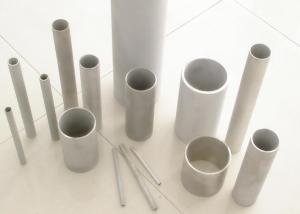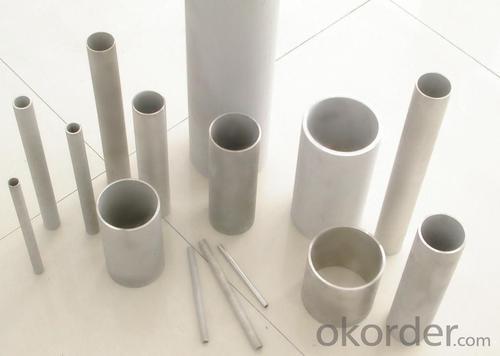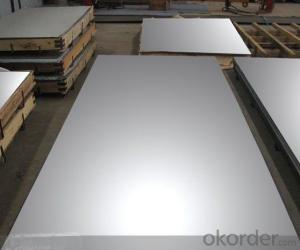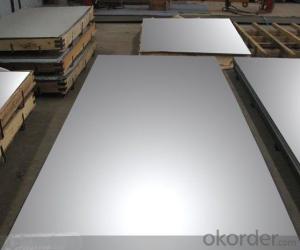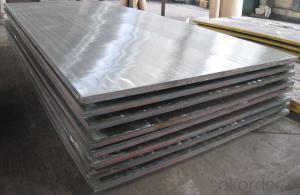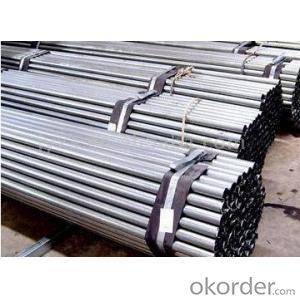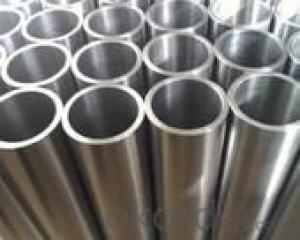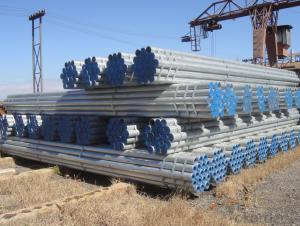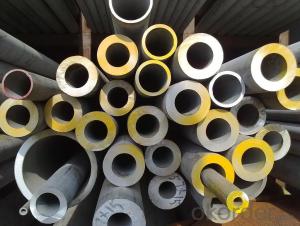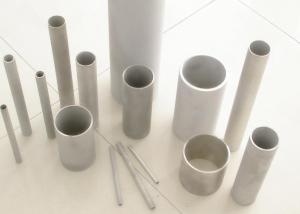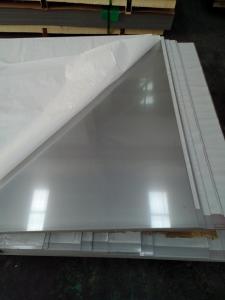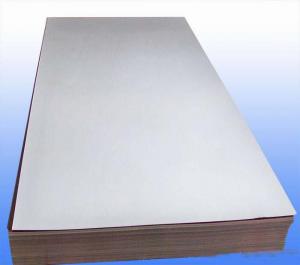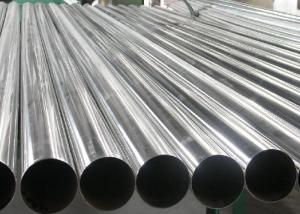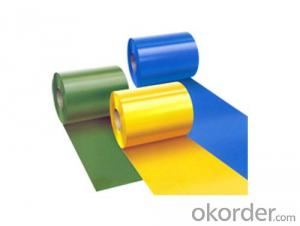316L Stainles Steel Seamless Pipe
- Loading Port:
- China Main Port
- Payment Terms:
- TT or LC
- Min Order Qty:
- 5 Tons m.t.
- Supply Capability:
- 10000TON/M m.t./month
OKorder Service Pledge
OKorder Financial Service
You Might Also Like
316L Stainless Steel Seamless Pipe
Application Of 304 Stainless Steel Seamless Pipe
Construction industry.
Chemical industry
Water tube
Pulp&Paper making industry
Heat exchanger tube,boiler tube,condenser tube,etc.
Available size range of 304 L Stainless Steel Seamless Pipe
OUTSIDE DIAMETER | WALL THICKNESS | |||||||
INCH | MM | Sch10 | Sch40 | STD | Sch80 | XS | Sch160 | XXS |
1/8" | 10.29 | 1.24 | 1.73 | 1.73 | 2.41 | 2.41 | - | - |
1/4" | 13.72 | 1.65 | 2.24 | 2.24 | 3.02 | 3.02 | - | - |
3/8” | 17.15 | 1.65 | 2.31 | 2.31 | 3.20 | 3.20 | - | - |
1/2" | 21.34 | 2.11 | 2.77 | 2.77 | 3.73 | 3.73 | 4.78 | 7.47 |
3/4 " | 26.67 | 2.11 | 2.87 | 2.87 | 3.91 | 3.91 | 5.56 | 7.82 |
1'' | 33.40 | 2.77 | 3.38 | 3.38 | 4.55 | 4.55 | 6.35 | 9.09 |
1.1/4" | 42.16 | 2.77 | 3.56 | 3.56 | 4.85 | 4.85 | 6.35 | 9.70 |
1.1/2'' | 48.30 | 2.77 | 3.68 | 3.68 | 5.08 | 5.08 | 7.14 | 10.15 |
2" | 60.30 | 2.77 | 3.91 | 3.91 | 5.54 | 5.54 | 8.74 | 11.07 |
2 1/2" | 73.03 | 3.05 | 5.16 | 5.16 | 7.01 | 7.01 | 9.53 | 14.02 |
3" | 88.90 | 3.05 | 5.49 | 5.49 | 7.62 | 7.62 | 11.13 | 15.24 |
3 1/2” | 101.60 | 3.05 | 5.74 | 5.74 | 8.08 | 8.08 | - | - |
4'' | 114.30 | 3.05 | 6.02 | 6.02 | 8.56 | 8.56 | 13.49 | 17.12 |
5” | 141.30 | 3.40 | 6.55 | 6.55 | 9.52 | 9.52 | 15.88 | 19.05 |
6" | 168.30 | 3.40 | 7.11 | 7.11 | 10.97 | 10.97 | 18.26 | 21.96 |
8'' | 219.08 | 3.76 | 8.18 | 8.18 | 12.70 | 12.70 | 23.01 | 22.23 |
10” | 273.05 | 4.19 | 9.27 | 9.27 | 15.08 | 12.70 | 28.58 | 25.40 |
12" | 323.85 | 4.57 | 9.52 | 9.53 | 17.45 | 12.70 | 33.32 | 25.40 |
14" | 355.60 | 4.78 | 11.13 | 9.53 | 19.05 | 12.70 | 35.71 | - |
16" | 406.40 | 4.78 | 12.70 | 9.53 | 21.44 | 12.70 | 40.49 | - |
18" | 457.20 | 4.78 | 14.27 | 9.53 | 23.83 | 12.70 | 45.24 | - |
20" | 508.00 | 5.54 | 15.09 | 9.53 | 26.19 | 12.70 | 50.01 | - |
22" | 558.80 | 5.54 | - | 9.53 | 28.58 | 12.70 | 53.98 | - |
24" | 609.60 | 6.35 | 17.48 | 9.53 | 30.96 | 12.70 | 59.54 | - |
Note : We can also produce the sizes beyond this table according to the requirements of customers
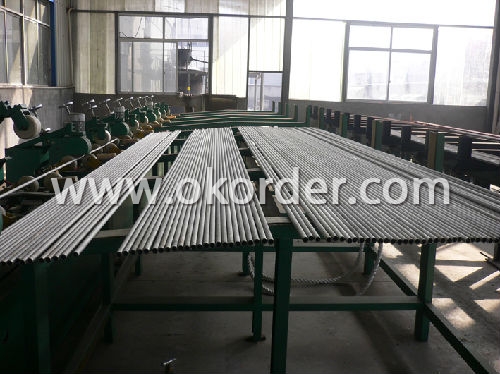
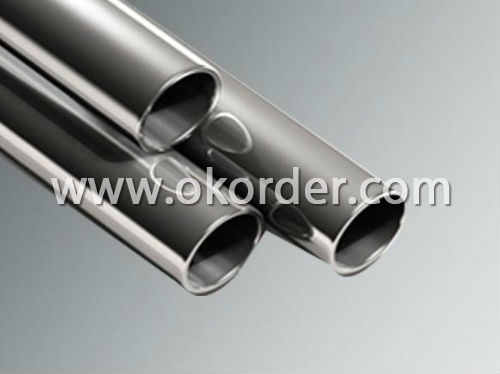
- Q: Can stainless steel sheets be used for wire mesh?
- Certainly, wire mesh can be made from stainless steel sheets. Stainless steel, being a highly versatile material, finds extensive usage across numerous applications owing to its exceptional durability, resistance to corrosion, and strength. Once stainless steel sheets undergo processing to transform into wire mesh, they acquire a robust and dependable mesh structure. Industries like construction, agriculture, mining, and filtration often employ stainless steel wire mesh due to its remarkable ability to endure harsh environments, withstand rust and corrosion, and uphold its structural integrity throughout time.
- Q: Can stainless steel sheets be used in outdoor environments?
- Yes, stainless steel sheets can be used in outdoor environments. Stainless steel is highly resistant to corrosion, making it suitable for outdoor applications. It can withstand exposure to harsh weather conditions, such as rain, sunlight, and temperature fluctuations, without deteriorating. Additionally, stainless steel is also resistant to rust, staining, and oxidation, further enhancing its suitability for outdoor use. This makes stainless steel sheets a popular choice for various outdoor applications, including construction, architecture, signage, and outdoor furniture.
- Q: Are stainless steel sheets resistant to abrasion?
- Yes, stainless steel sheets are highly resistant to abrasion.
- Q: How do stainless steel sheets resist corrosion?
- Due to its unique composition and the presence of a protective oxide layer, stainless steel sheets have the ability to resist corrosion. Stainless steel is comprised of iron, chromium, and other alloying elements like nickel and molybdenum. Chromium is particularly essential for the corrosion resistance of stainless steel. When exposed to oxygen, chromium creates a thin and invisible oxide layer on the surface of the stainless steel, which is referred to as the passive layer. This passive layer acts as a barrier, preventing oxygen and moisture from reaching the underlying metal and safeguarding it against corrosion. This layer is the reason why stainless steel is called "stainless," as it remains free from rust and corrosion. The chromium oxide layer has the ability to self-repair and reform if it gets damaged or scratched, ensuring continuous protection for the stainless steel. This characteristic enables stainless steel sheets to be utilized in various environments, including those with high humidity, exposure to chemicals, and even saltwater. Furthermore, alloying elements such as nickel and molybdenum enhance the corrosion resistance of stainless steel. Nickel enhances the stability and strength of the passive layer, while molybdenum improves resistance against pitting and crevice corrosion. Moreover, surface finishes like polishing or passivation can provide additional protection against corrosion for stainless steel sheets. These processes eliminate any contaminants or impurities from the surface and promote the formation of a stronger and more uniform passive layer. In conclusion, the combination of chromium, other alloying elements, and the protective oxide layer makes stainless steel sheets extremely resistant to corrosion, ensuring durability and longevity in a wide range of applications.
- Q: What are the specifications of stainless steel plates? Are they the same width?
- Different specifications, width is not the same, there are 1.22 meters, 1 meters, etc., length, width, thickness are different.
- Q: Can stainless steel sheets be used for swimming pool construction?
- Indeed, swimming pool construction can utilize stainless steel sheets. Stainless steel, being a robust and corrosion-resistant material, proves to be an exceptional selection for pool construction. Its ability to endure chemicals and withstand the harsh swimming pool conditions, such as exposure to chlorine and saltwater, is highly commendable. Moreover, stainless steel sheets are effortless to clean and maintain, rendering them a popular choice for both residential and commercial swimming pools. Additionally, stainless steel adds a touch of sophistication and modernity, ultimately enhancing the pool's overall appearance. However, it is crucial to guarantee the usage of high-quality stainless steel sheets that meet industry standards to ensure prolonged performance and safety.
- Q: What is the electrical resistance of stainless steel sheets?
- The electrical resistance of stainless steel sheets can vary depending on various factors such as the grade of stainless steel, its thickness, and the specific properties of the alloy used. Generally, stainless steel is known to have a relatively high electrical resistance compared to other metals. This is due to its composition, which includes a significant amount of chromium and other alloying elements that hinder the flow of electric current. However, the exact value of electrical resistance can range from a few micro-ohms per square meter to several ohms per square meter, depending on the specific grade and thickness of the stainless steel sheet. Therefore, it is crucial to consult the manufacturer's specifications or conduct specific electrical resistance tests to obtain accurate values for a particular stainless steel sheet.
- Q: How long do stainless steel sheets last?
- Stainless steel sheets are renowned for their durability and long-lasting nature. The lifespan of these sheets can vary depending on factors like the grade and quality of the stainless steel, environmental conditions, and maintenance practices. However, with proper care and normal circumstances, stainless steel sheets can endure for many decades or even a lifetime. The longevity of stainless steel is greatly influenced by its ability to resist corrosion. This is made possible by the presence of chromium, which forms a passive layer on the surface of the material, safeguarding it from rust and corrosion. This natural protective layer enables stainless steel sheets to withstand harsh environmental conditions, including exposure to moisture, chemicals, and extreme temperatures. Moreover, the grade of stainless steel also plays a role in its lifespan. There are different grades available, such as 304, 316, and 430, each offering varying levels of corrosion resistance. Higher grades, particularly 316 stainless steel, exhibit greater resistance to corrosion and are commonly used in marine and highly corrosive environments, ensuring a longer lifespan. To maximize the lifespan of stainless steel sheets, proper maintenance is crucial. Regular cleaning with mild detergents and non-abrasive materials is necessary to eliminate dirt, grime, and contaminants that can degrade the protective layer of stainless steel. Additionally, it is important to avoid contact with harsh chemicals or abrasive materials that can scratch or damage the surface. While stainless steel sheets have an impressive lifespan, it is important to acknowledge that their durability is not limitless. Over time, factors like wear and tear, exposure to severe conditions, or improper maintenance can gradually diminish the protective layer of stainless steel and reduce its lifespan. Nonetheless, with appropriate care and maintenance, stainless steel sheets can be a cost-effective and enduring choice for various applications, including construction, automotive, and household products.
- Q: What are the different types of stainless steel sheet embossing patterns available?
- A variety of stainless steel sheet embossing patterns are available, offering different visual and tactile effects. Some of the most commonly used patterns are: 1. Diamond: This pattern consists of evenly spaced diamond-shaped indentations across the sheet's surface, creating an appealing textured appearance. 2. Linen: Resembling the texture of linen fabric, this pattern features parallel lines running in one direction and intersecting perpendicular lines, adding a subtle and sophisticated look to stainless steel sheets. 3. Stucco: The stucco pattern creates a raised, pebble-like texture on the sheet's surface, commonly used in architectural applications to enhance visual interest and provide a tactile feel. 4. Leather: This pattern imitates the texture of leather, with irregular lines and indentations, giving stainless steel sheets a unique and luxurious appearance. 5. Hammered: The hammered pattern showcases irregular indentations resembling hammer marks, contributing to a rustic and handcrafted look on stainless steel sheets. 6. Checkerboard: This pattern forms a grid of squares, with alternating squares raised or recessed, resulting in a classic and geometric design on stainless steel sheets. 7. Wave: The wave pattern showcases curved lines resembling ocean waves, adding a dynamic and flowing look to stainless steel sheets. These examples represent only a fraction of the available stainless steel sheet embossing patterns. Each pattern can be customized in terms of size, depth, and spacing to meet specific design preferences and application requirements.
- Q: What are the different types of stainless steel sheet alloys?
- Stainless steel sheet alloys come in various types, each possessing unique properties and characteristics. Below are some of the commonly used types: 1. Austenitic stainless steel, the most widely used alloy, is known for its excellent formability and high corrosion resistance. Industries like food processing, pharmaceuticals, and architecture often use grades like 304 and 316. 2. Ferritic stainless steel, which has a higher carbon and lower chromium content compared to austenitic steel, offers good corrosion resistance and high strength. It finds applications in areas requiring high temperature resistance, such as automotive exhaust systems. 3. Martensitic stainless steel alloys, with higher carbon and lower chromium content than both austenitic and ferritic steels, are valued for their high strength, hardness, and corrosion resistance. They are commonly used in cutlery, surgical instruments, and turbine blades. 4. Duplex stainless steel combines the properties of austenitic and ferritic steels, providing a balance between strength and corrosion resistance. It is widely used in chemical processing, oil and gas, and marine industries. 5. Precipitation-hardening stainless steel is heat treatable and can achieve high strength and hardness through a precipitation-hardening process. It is critical in aerospace and defense applications that require both strength and corrosion resistance. These examples represent only a fraction of the available stainless steel sheet alloys. The choice of alloy depends on specific application requirements, such as corrosion resistance, strength, and temperature resistance.
Send your message to us
316L Stainles Steel Seamless Pipe
- Loading Port:
- China Main Port
- Payment Terms:
- TT or LC
- Min Order Qty:
- 5 Tons m.t.
- Supply Capability:
- 10000TON/M m.t./month
OKorder Service Pledge
OKorder Financial Service
Similar products
Hot products
Hot Searches
Related keywords
